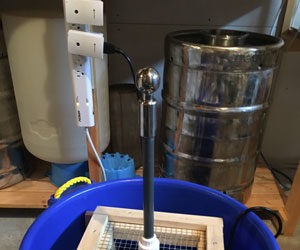Chest Freezer to Kegerator (Keezer Collar Build)

When I returned to homebrewing in 2008 after a several year-long hiatus, I quickly tired of bottling beer on the kitchen floor. Wha t was once no big deal had became a pain in my backside, literally, and I quickly began looking for kegging solutions. Finding several successful freezerconversion projects on the web convinced me that the method does indeed work — e.g. running a freezer at refrigerator temperatures.
Like many folks, I do not have heaps of time on my hands for projects, and my woodworking skills are intermediate at best. I also wanted the kegerator in my family room so a measure of elegance was needed, and, as my large family needs all the space we can find, I also wanted to easily move the unit around as needed.
I found several inspiring stories about freezer conversions on the Web, including a forum thread where homebrewers showed off their kegerators. There were lots of different approaches and styles collected in one place. Armed with those ideas, I started planning . . .
Guide to Parts
I found a black Frigidaire 7.2-cubic-foot chest freezer at Lowe’s on sale for $228.00. (This would be the most expensive part of the project, but starting from a new freezer rather than a used one gave me a perfect finish without spending a lot of time restoring it.)
I installed a wood collar between the freezer body and the lid, to increase the internal height so I could fit more kegs, and also to provide a surface that I could drill through for taps and such without fear of hitting a refrigerant line.
There is a debate among homebrewers which is better; the collar attached to the lid or to the freezer body. Perhaps the best argument for a collar-on-body installation (like mine) is that it is easier to build. One compelling argument for the collar-on-lid installation is that it is hard to lift a full keg over the collar into the freezer, so if the collar lifts with the lid there is less height to lift the keg over.
It is getting harder to find Cornelius kegs at bargain prices. I got two with a 5# CO2 bottle and dual regulator for $189.00 at kegconnection.com, and four more kegs from eBay for $130.
I have wasted much beverage line by buying pieces that are too short. Eventually I found that I needed around 10 feet of 3⁄16” beverage line for each tap, serving at 10–12 psi. Anything less foamed excessively. If you’re not sure, I recommend using online calculators to figure how much beverage line you need. For higher serving pressures you will need more. I coil the lines and wrap them with hook-and-loop straps usually used to organize computer cables to keep them organized.
Parts and Supplies
• Chest Freezer (Frigidaire 7.2 ft³)
• Two pieces of 2-inch x 8-inch x 8-foot (5 cm x 20 cm x 2.4 m) lumber
• Foam panel, 1.5-inch x 24-inch x 96-inch (3.8 cm x 61 cm x 244 cm)
• PL300 foam panel adhesive
• Wood stain (I used Zinsser “Cabernet”)
• Minwax polyurethane
• Four casters, 3-inch (7.6 cm), fixed and swivel
• Two Cornelius kegs (5#), CO2 bottle, dual regulator, hoses and quick disconnects (w. hose barbs)
• Gas manifolds
• Beverage tubing, 3⁄16-inch x 40-foot
• 13 feet (4 m) of 5⁄16-inch gas tubing
• Four gas and four beverage ball lock disconnects FL, swivel nuts
• Love TSX-10140 temperature controller
• Masscool 120-mm fan
• Starr bottle opener with cap catcher
• Perlick 525SS faucets w. handles (4 pcs)
• 3-inch (7.6 cm) stainless steel beer shanks, (4 pcs)
• Ball lock kegs, 4 pcs
• Drip tray 19.25-inch
• 3M Scotch 4011 exterior mounting tape


